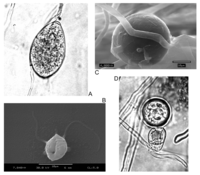
Photo from wikipedia
Potato flakes (PFs) are made by boiling, mashing and subsequent drying of steam peeled potatoes. Their cold-water swelling starch readily develops viscosity upon hydration. That potato starch amylopectin (AP) contains… Click to show full abstract
Potato flakes (PFs) are made by boiling, mashing and subsequent drying of steam peeled potatoes. Their cold-water swelling starch readily develops viscosity upon hydration. That potato starch amylopectin (AP) contains esterified phosphate groups results in rapid swelling and high viscosity of PF suspensions. This study is the first report on the impact of sodium, calcium and aluminum chloride on (i) the physicochemical properties of PFs and (ii) the water dynamics in relation to oil uptake in the production of deep-fried crisps made thereof. Adding 125 μmol cation/g PF dry matter (dm) of these salts to PF suspensions (8.0% dm) in a Rapid Visco Analyzer (RVA) decreased the peak viscosities by 5% (sodium chloride) and 20% (calcium or aluminum chloride). While monovalent cations shield the negative charges of the phosphate monoesters on the starch chains, divalent and trivalent cations bridge phosphate groups of adjacent AP molecules and thereby reduce swelling even further. Moreover, the latter ions result in up to 20% higher RVA cold paste viscosity readings even if they do not affect amylose (AM) aggregation. They thus enhance the gelation of PFs by AP bridging. For producing deep-fried crisps, PFs, emulsifier and maltodextrin were hydrated, mixed, sheeted into dough, and deep-fried. Including the above dosage of calcium ions in its recipe increased the specific strength of the dough sheet by about 15%. Time domain proton nuclear magnetic resonance analysis of dough sheets showed that these ions increase the rigidity of the starchy gel network while AM crystallization remains largely unaffected. This is evidence that ionic cross-linking of AP directly strengthens the dough sheet. Moreover, the calcium ions lowered the lipid content of the deep-fried crisps by about 5% due to stronger interaction of starch polymers with water. Ionic cross-linking of AP thus improves the gel forming capacity of PFs and strengthens the starchy gel network during manufacturing of potato-based snacks resulting in crisps with a significantly lower lipid content.
Journal Title: Food research international
Year Published: 2019
Link to full text (if available)
Share on Social Media: Sign Up to like & get
recommendations!